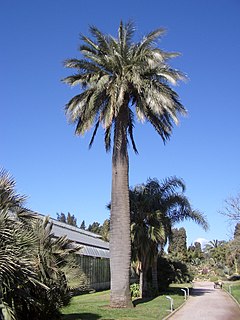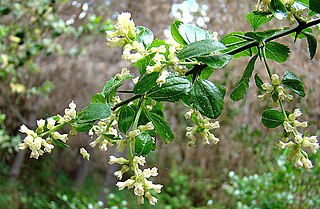
Alder is the common name of a genus of flowering plants, Alnus, belonging to the birch family Betulaceae. The genus comprises about 35 species of monoecious trees and shrubs, a few reaching a large size, distributed throughout the north temperate zone with a few species extending into Central America, as well as the northern and southern Andes.

The Casuarinaceae are a family of dicotyledonous flowering plants placed in the order Fagales, consisting of four genera and 91 species of trees and shrubs native to eastern Africa, Australia, Southeast Asia, Malesia, Papuasia, and the Pacific Islands. At one time, all species were placed in the genus Casuarina. Lawrence Alexander Sidney Johnson separated out many of those species and renamed them into the new genera of Gymnostoma in 1980 and 1982, Allocasuarina in 1982, and Ceuthostoma in 1988, with some additional formal descriptions of new species in each other genus. At the time, it was somewhat controversial. The monophyly of these genera was later supported in a 2003 genetics study of the family. In the Wettstein system, this family was the only one placed in the order Verticillatae. Likewise, in the Engler, Cronquist, and Kubitzki systems, the Casuarinaceae were the only family placed in the order Casuarinales.

Rhamnaceae is a large family of flowering plants, mostly trees, shrubs, and some vines, commonly called the buckthorn family. Rhamnaceae is included in the order Rosales.

Ceanothus is a genus of about 50–60 species of nitrogen-fixing shrubs and small trees in the buckthorn family (Rhamnaceae). Common names for members of this genus are buckbrush, California lilac, soap bush, or just ceanothus. "Ceonothus" comes from a Greek word meaning "spiny plant", Ancient Greek: κεάνωθος (keanōthos), which was applied by Theophrastus to an Old World plant believed to be Cirsium arvense.

Dryas is a genus of perennial cushion-forming evergreen dwarf shrubs in the family Rosaceae, native to the arctic and alpine regions of Europe, Asia and North America. The genus is named after the dryads, the tree nymphs of ancient Greek mythology. The classification of Dryas within the Rosaceae has been unclear. The genus was formerly placed in the subfamily Rosoideae, but is now placed in subfamily Dryadoideae.
Diazotrophs are bacteria and archaea that fix atmospheric nitrogen gas into a more usable form such as ammonia.

Cercocarpus, commonly known as mountain mahogany, is a small genus of at least nine species of nitrogen-fixing flowering plants in the rose family, Rosaceae. They are native to the western United States and northern Mexico, where they grow in chaparral and semidesert habitats and climates, often at high altitudes. Several are found in the California chaparral and woodlands ecoregion.

Root nodules are found on the roots of plants, primarily legumes, that form a symbiosis with nitrogen-fixing bacteria. Under nitrogen-limiting conditions, capable plants form a symbiotic relationship with a host-specific strain of bacteria known as rhizobia. This process has evolved multiple times within the legumes, as well as in other species found within the Rosid clade. Legume crops include beans, peas, and soybeans.

Frankia is a genus of nitrogen-fixing, bacteria that live in symbiosis with actinorhizal plants, similar to the Rhizobium bacteria found in the root nodules of legumes in the family Fabaceae. Frankia also initiate the forming of root nodules.

Discaria is a genus of 6 species of flowering plants in the family Rhamnaceae, native to temperate regions of the Southern Hemisphere, in Australia, New Zealand and South America.

Purshia is a small genus of 5-8 species of flowering plants in the family Rosaceae, native to western North America, where they grow in dry climates from southeast British Columbia in Canada south throughout the western United States to northern Mexico. The classification of Purshia within the Rosaceae has been unclear. The genus was originally placed in the subfamily Rosoideae, but is now placed in subfamily Dryadoideae.

Jubaea is a genus of palms with one species, Jubaea chilensis or Jubaea spectabilis, commonly known in English as the "Chilean wine palm" or "Chile cocopalm", and "palma chilena" in Spanish. It is native to southwestern South America and is endemic to a small area of central Chile between 32°S and 35°S in southern Coquimbo, Valparaíso, Santiago, O'Higgins, and northern Maule regions.

Colletia is a genus of flowering plants in the family Rhamnaceae, with 5 species of spiny shrubs. All species of this genus are native to southern South America. They are non-legume nitrogen fixers.
Actinorhizal plants are a group of angiosperms characterized by their ability to form a symbiosis with the nitrogen fixing actinobacteria Frankia. This association leads to the formation of nitrogen-fixing root nodules.
Retanilla trinervia is a species of actinorhizal plant within the family Rhamnaceae; this dicotyledon flora is a shrub or small tree. R. trinervia is notable for its ability to fix nitrogen. This species mainly occurs in the near coastal forests and arid shrubland of Chile. Example occurrences are found in the mountains of central Chile; for example, it occurs in the La Campana National Park in association with Acacia caven and Jubaea chilensis. as well as other proximate areas of central Chile.

Frankia alni is a Gram-positive species of actinomycete filamentous bacterium that lives in symbiosis with actinorhizal plants in the genus Alnus. It is a nitrogen-fixing bacterium and forms nodules on the roots of alder trees.
Gamocarpha is a genus of flowering plants in the family Calyceraceae, native to the Andes of Chile and Argentina. It has been proposed to synonymize the genus Nastanthus within Gamocarpha.

Corynabutilon is a genus of flowering plants in the family Malvaceae, native to southern Chile and Argentina. They are shrubs or small trees.
Ochetophila is a genus of flowering plants in the family Rhamnaceae, native to Chile and Argentina. The species in this genus are actinorhizal plants.

Retanilla is a genus of flowering plants in the family Rhamnaceae, native to Chile, Peru, and Argentina. The species in this genus are actinorhizal plants.















